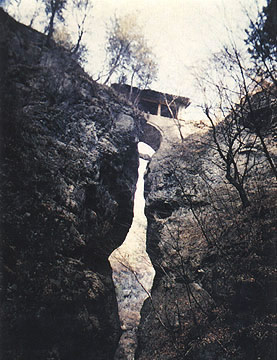

 |
| Lingkong Mountain Natural Protection Scenic?Area |
The city of Changzhi is located in the southeastern part of Shanxi province, neighboring Hebei and Henan provinces beyond the Taihang Mountains to the east, the city of Linfen across Taiyue Mountain to the west, the city of Jincheng to the south, and the city of Jinzhong to the north.
It covers a 13,896-square-kilometer area and had a population of 3.35 million at the end of 2011, with 43 percent of it in the urban area. The city plain covers 2,213 sq km, while hills account for 4,641 sq km, and a mountainous part for 7,042 sq km. The Beitai Peak of Taiyuan Mountains is 2,453 meters high, Shanxi’s highest point. The city is not extremely cold in winter nor is it extremely hot in summer, and is a very livable place with four distinct seasons and a somewhat humid climate.
Changzhi is one of the homes of Chinese civilization and had people in the area as early as 10,000 years ago according to archaeological findings, so many prehistoric myths and legends got their start here. It has plenty of natural resources, including coal, iron, silicon, and marble, with coal reserves reaching 27.4 billion tons. It also has abundant water, with around 2.29 billion cubic meters of it. It has forest coverage of 26.8 percent and four national forest parks. It has an outstanding location with convenient transportation and is near the Circum-Bohai Sea Economic Zone, the Longhai Economic Zone, and the central Henan urban concentration. It has a transportation network of railways, highways, and aviation. It also has a good economic base with its industrial system covering coal, chemicals, metallurgy, electric power, machinery manufacturing, and pharmaceuticals. It is also a major rice producer with good agricultural conditions and 25 national agricultural demonstration areas and grows improved varieties of corn, peppers, and walnuts.
The city's GDP was 121.86 billion yuan ($19.88 billion) in 2011, up 15.4 percent from 2010, with primary industrial added-value output reaching 4.9 billion yuan, for an increase of 7.7 percent year-on-year; secondary industrial output at 82.73 billion yuan, up 18.4 percent; and tertiary industrial output at 34.23 billion yuan, up 10.2 percent. Per capita GDP was 36,425 yuan, up 14.9 percent from the previous year.
Annual revenues were 25.5 billion yuan, a growth of 29.1 percent and general expenditures were 17.61 billion yuan, up 29.6 percent, with social security and employment expenditures showing an increase of 52.6 percent, medical care and public health, 43.9 percent, science and technology, 57.5 percent, education, 16.8 percent, and agriculture, forests, and watery areas, 35.8 percent.
The city has 24 tourist routes, including one for red tourism, Yan Emperor culture, and a Taihang Mountain Grand Canyon scenic spot.